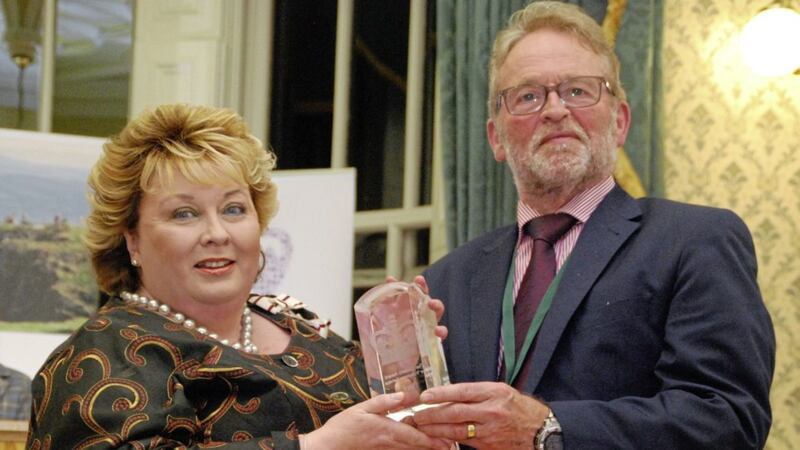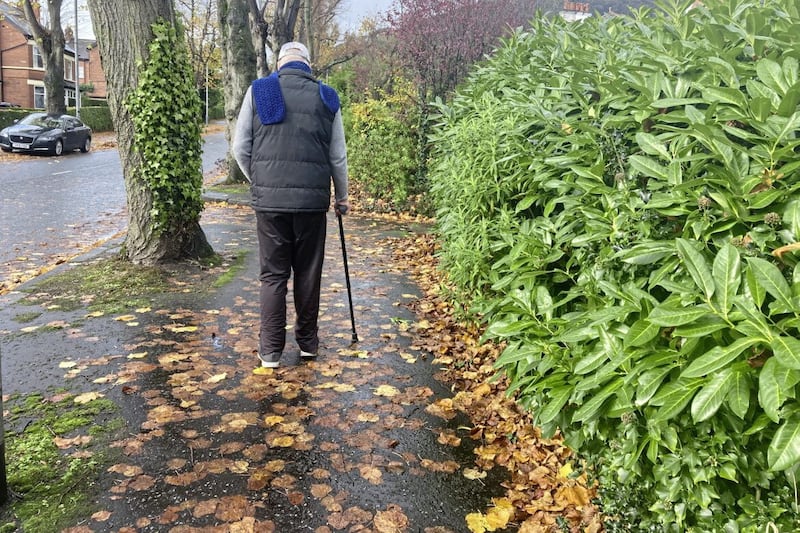THE Cave Hill dominates Belfast, strong and silent and beautiful. This time of year it looks like there’s an old musquash fur coat draped down the slopes with the gold and ochre of its many trees.
Most of us take it for granted but there is a lot of work keeping such a historic monument in prime condition and this achievement was celebrated last week when the Lord Lieutenant for the county borough of Belfast, Fionnuala Jay-O'Boyle CBE, presented the Cave Hill Conservation Campaign with the Queen's Award for Voluntary Service for 30 years dedicated work.
More than 100 volunteers and guests gathered at Belfast Castle for the occasion when chairman Cormac Hamill accepted the QAVS award. Cormac has been champion of the Cave Hill for years. He admits he was an Armagh boy who fell for a north Belfast girl and ended up living beside the hill.
“I was a country boy and the Cave Hill was important; it was the only place I could get my head above Belfast!”
Thanks to Cormac and the many volunteers who have kept this marvellous landmark in pristine condition and battled the vandals.
Find out more about the educational side of the organisation, the many talks and walks and the magazine at cavehillconservation.org
War Of Words
I SIMPLY can’t understand the war that is raging about Irish and Ulster Scots. Sure we all use words from each – they're ingrained in our every day speech. Let’s celebrate this instead of allowing it to come between us. Our traditions are interlinked and we should treasure this.
This will be discussed on October 10 at the Island Arts Centre in Lisburn when Liam Logan, author of One Rhymes, and Linda Ervine will bring each of their interests before the audience. As Liam says, Linda is the Protestant loving the Irish language and he’s the Catholic delighting in Ulster Scots.
Ulster Scots first came to my ear working with Tom McDevitte who was a regular on television as Barney McCoole hanging over the farm gate and telling us he was "Livin’ in Dunlister and clabber to the knee".
Soon before he died I had a long talk with Dr Ian Anderson who was founder of the Ulster Scots Language Society. I asked him the $64 million question – is it a dialect or a language? Ever the diplomat, he replied: “Some say it’s a dialect and others say it’s a language.” Liam, expert on the subject, would agree.
Which ever it is, it’s a beautiful lilting way of expressing yourself. Isn’t a ‘gulder’ more impressive than a shout? Bad wee skitter gets the message across where a naughty little boy has little impact and isn't there more feeling to ‘thole’ than to suffer?
However, Liam warns about a common word – ‘fouter’. We often fouter about but this is an Ulster Scots word from medieval French origins for the ‘physical act of lovemaking’.
This broadcaster, author and journalist points out that language changes through time. He likes to tell the story of Christopher Wren.
“When Wren was walking past St Paul’s Cathedral with Charles II the architect asked the king’s opinion. 'Monstrous and awful,' was the reply. Actually he meant ‘huge’ and ‘fills me with awe.’”
Liam also told me that Greeks named the Barbarians after the way they spoke – to the Greek ear it was ‘bar-bar-bar-bar-bar’. Hence Barbarians. Obviously translating is a skill.
Bible Studies
Interestingly I once interview Heather and Philip Saunders who at the time, and working through the Wycliffe Bible Translators, translated the Gospel according to St Luke into Ulster Scots. Their hope was to present the entire New Testament to the world and, who knows, perhaps even the entire Bible in Ulster Scots – a Herculean task.
Thanks to Master McAlarey, Liam learned some historic poetry when he was at school, Macaulay’s Horatio At The Bridge, Noyes' ghostly The Highwayman and, closer to home, WF Marshall, the Bard of Tyrone. His native speech was in the air he breathed in north Antrim and gave him a lexicon for life.
Liam is well known on radio and television for his programmes featuring the Ulster Scots and Nine Rhymes is his third book, beautifully illustrated by another Dunloy boy, Billy Mawhinney.
Nine Rhymes is just that – nine expressive works full of humour and wisdom all varied and fascinating to read – out loud is best.
If ye minded ivry minute o yer life, ye couldnae think
Aal ye mine is bits and odds, whiles it’s jist a blink
There stuff that’s kina hazy an ither bits that’s clear
Here’s a tale haes styed wae me for nearly fifty year.
And so the tales go on about The Return o John Mann, Granny We Hardly Knew Ye and A Kailye Frae Santy – (After a visit from St Nicholas by Clement Clarke Moore).
The nicht afore Christmas an a roon the hoose
Naw yin thing was stirrin, naw even a moose
The socks were a hung bae the chimley wae care
Hopin Oul Santy would shane be doon there.
The only thing about Ulster Scots is the fact that my spell check has almost had a nervous breakdown! Well worth it.
:: ‘Now You’re Talking’, October 10, 7.30pm, Island Arts Centre, Lisburn; 028 9244 7452.
And Nine Rhymes (£9.99) is available in Waterstones bookshops.









